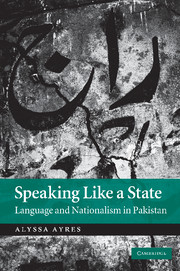Book contents
- Frontmatter
- Contents
- List of illustrations
- List of tables
- Acknowledgments
- Note on transliteration
- Introduction
- 1 Articulating a new nation
- 2 Urdu and the nation
- 3 The nation and its margins
- 4 The case of Punjab, part I: elite efforts
- 5 The case of Punjab, part II: popular culture
- 6 History and local absence
- 7 Bringing back the local past
- 8 Speaking like a state: language planning
- 9 Religion, nation, language
- 10 Conclusion
- Bibliography
- Index
9 - Religion, nation, language
Published online by Cambridge University Press: 25 August 2009
- Frontmatter
- Contents
- List of illustrations
- List of tables
- Acknowledgments
- Note on transliteration
- Introduction
- 1 Articulating a new nation
- 2 Urdu and the nation
- 3 The nation and its margins
- 4 The case of Punjab, part I: elite efforts
- 5 The case of Punjab, part II: popular culture
- 6 History and local absence
- 7 Bringing back the local past
- 8 Speaking like a state: language planning
- 9 Religion, nation, language
- 10 Conclusion
- Bibliography
- Index
Summary
We the sons and daughters of Indonesia uphold as the language of unity the Indonesian language.
Part three of the 1928 Sumpah Pemuda, the “Youth Pledge” of Indonesia's young nationalistsWhat makes a language national, beloved, and a force for unity? This question has been answered most typically with long disquisitions on civilizational history and the unique role of language and culture in evidencing a people's force on earth. In 1928, the youth nationalists at the vanguard of the early independence movement for the Dutch East Indies chose to invoke the “Indonesian language” as a central tenet of their movement. Yet by the time of Independence in 1945 – seventeen years after the youth pledge had identified Bahasa Indonesia as a core unifier of the country's nationalism – a mere 4.9 percent of the population spoke it as a first language. In truth, the language identified as the language of national unity would have to be “developed” and propagated as a language, and with national reach, much after the moment at which it was held up as a national force. Through language planning, the modern Indonesian state created a language of unity that has indeed fulfilled the aspirations of the country's early advocates for freedom, and the story of independent Indonesia's efforts to make this language truly national stands as one of the most remarkable successes of modern nation-building in history.
- Type
- Chapter
- Information
- Speaking Like a StateLanguage and Nationalism in Pakistan, pp. 171 - 187Publisher: Cambridge University PressPrint publication year: 2009



